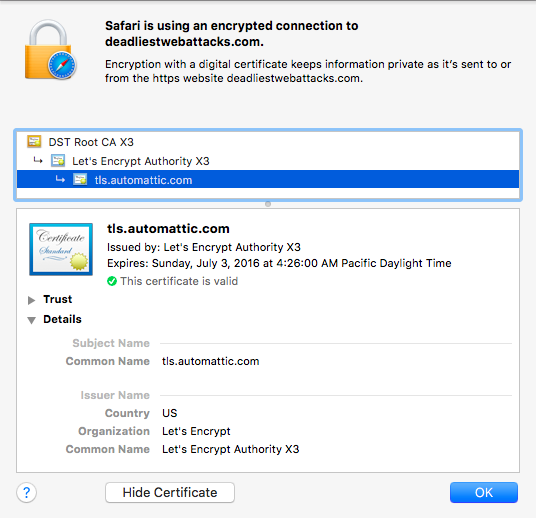I'll ne'er look you i' the plaintext again
The alphabetically adjacent domains when this site was hosted at WordPress included air fresheners, web security, and cats. Thanks to Let’s Encrypt, all of those now support HTTPS by default.

Even better, WordPress serves the Strict-Transport-Security header to ensure browsers adhere to HTTPS when visiting it. So, whether you’re being entertained by odors, HTML injection, or felines, your browser is encrypting traffic.
Let’s Encrypt makes this possible for two reasons. The project provides free certificates, which addresses the economic aspect of obtaining and managing them. Users who blog, create content, or set up their own web sites can do so with free tools. But the HTTPS certificates were never free and there was little incentive for them to spend money. To further compound the issue, users creating content and web sites rarely needed to know the technical underpinnings of how those sites were set up (which is perfectly fine!). Yet the secure handling and deployment of certificates requires more technical knowledge.
Most importantly, Let’s Encrypt addressed this latter challenge by establishing a simple, secure ACME protocol for the acquisition, maintenance, and renewal of certificates. Even when (or perhaps especially when) certificates have lifetimes of one or two years, site administrators would forget to renew them. It’s this level of automation that makes the project successful.
Hence, WordPress can now afford – both in the economic and technical sense – to deploy certificates for all the custom domain names it hosts. That’s what brings us to the cert for this site, which is but one domain in a list of SAN entries from deadairfresheners to a Russian-language blog about, inevitably, cats.
Yet not everyone has taken advantage of the new ease of encrypting everything. Five years ago I wrote about Why You Should Always Use HTTPS. Sadly, the article itself is served only via HTTP. You can request it via HTTPS, but the server returns a hostname mismatch error for the certificate, which breaks the intent of using a certificate to establish a server’s identity.
As with all things new, free, and automated, there will be abuse. For one, malware authors, phishers, and the like will continue to move towards HTTPS connections. The key point there being “continue to”. Such bad actors already have access to certs and to compromised financial accounts with which to buy them. There’s little in Let’s Encrypt that aggravates this.
Attackers may start looking for letsencrypt clients in order to obtain certs by fraudulently requesting new ones. For example, by provisioning a resource under a well-known URI for the domain (this, and provisioning DNS records, are two ways of establishing trust to the Let’s Encrypt CA).
Attackers may start accelerating domain enumeration via Let’s Encrypt SANs. Again, it’s trivial to walk through domains for any SAN certificate purchased today. This may only be a nuance for hosting sites or aggregators who are jumbling multiple domains into a single cert.
Such attacks aren’t proposed as creaky boards on the Let’s Encrypt stage. They’re merely reminders that we should always be reconsidering how old threats and techniques apply to new technologies and processes. For many ”astounding” hacks of today, there are likely close parallels to old Phrack articles or basic security principles awaiting clever reinterpretation for our modern times.

Finally, I must leave you with some sort of pop culture reference, or else this post wouldn’t befit the site. This is the 400th anniversary of Shakespeare’s death. So I shall leave you with a quote from Julius Caesar:
Nay, an I tell you that, Ill ne’er look you i’ the
face again: but those that understood him smiled at one
another and shook their heads; but, for mine own part, it
was Greek to me. I could tell you more news too: Marullus
and Flavius, for pulling scarfs off Caesar’s images, are
put to silence. Fare you well. There was more foolery
yet, if I could remember it.
May it take us far less time to finally bury HTTP and praise the ubiquity of HTTPS. We’ve had enough foolery of unencrypted traffic.